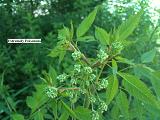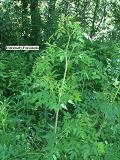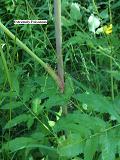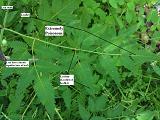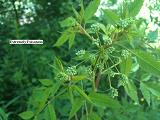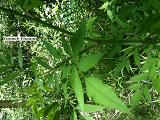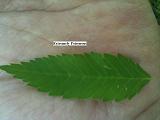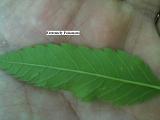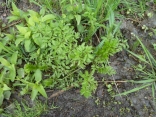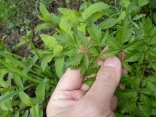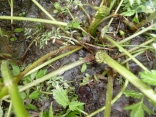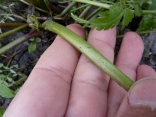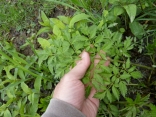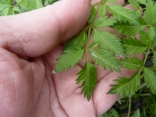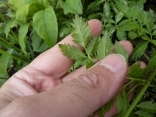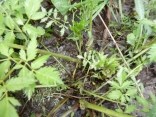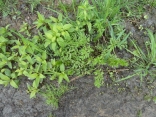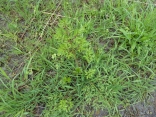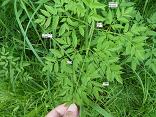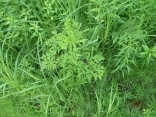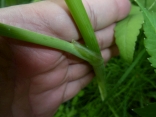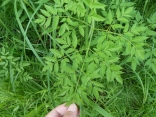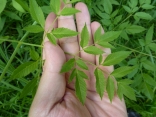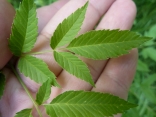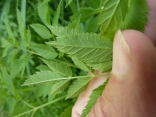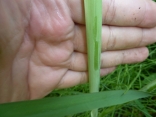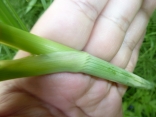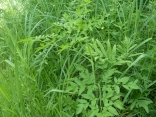It is always useful to know your local poisonous plants so you can avoid them. Water Hemlock is extremely poisonous and one to avoid. Keep in mind that there is another poisonous Water Hemlock plant in New Hampshire called Bulbet-Bearing Water Hemlock (Cicuta bulbifer) which looks somewhat different but is also extremely poisonous. (See http://wisplants.uwsp.edu/scripts/detail.asp?SpCode=CICBUL.) This description applies to the Spotted Water Hemlock (Cicuta maculata). A few of the noticeable aspects of Spotted Water Hemlock are:
- Carrot-like umbrel (groups of flowers emminating from a single point at the top of the plant)
- Hairless (smooth) stem
- Purplish parts to the stem. Although some younger stems seem to lack the purple except around the leaf joints.
- Double Pinnately-Compound Leaves
- Leaflet veins run into the sinuses between the teeth.
- Tends to be found near bodies of water (but not necessarily in the water).
- Tends to be found near bodies of water (but not necessarily in the water).
These plants are growing on both side of a wide trail. On one side of the trail is a Cattail
marsh and 20 yards from the other side of the trail is a river. The trail sometimes
gets slightly flooded after a rain, but often times these Water Hemlock plants are on dry
ground.
- Carrot-like umbrel (groups of flowers emminating from a single point at the top of
the plant). As you can see in the picture in the left of the 1st row of pictures,
there are a number of
little umbrels of flowers at the top of the plant. In young plants, I suspect you might not
see these umbrels, so I would not use this as the sole identifying characteristic.
- Hairless (smooth) stem. If you expand the picture on the right of the 1st
row of pictures, you may be
able to see that Water Hemlock has a very smooth stem.
- Purplish parts to the stem. Although some younger stems seem to lack the purple except
around the leaf joints. You can see the purplish part on the picture on the left
of the 2nd row of pictures. But I did see a younger Water Hemlock without much purple
on the stem.
- Double Pinnately-Compound Leaves. I think this is one of the key identifying
characteristics. But in order to see this, you have to know what is a leaf and leaflet.
On a non-woody, herbacious plant, a leaf starts where there is either (1) stipules -- one or
often a pair of basal appendages to the growth of a leaf; or (2) A sheath attached to
the stem to mark the base of the leaf.
As you can see from the picture on the left of the 2nd row of pictures, there is a sheath that attaches to the stem to mark the base of the leaf. You can also see that in the picture on the right of the 2nd row of pictures -- the leaf sheath is on the far left of this picture. Note that this picture just shows one leaf stem. As you go down this leaf stem, you will see leaflets growing out of each side of the stem. This means that these leaflets are pinnately compound (they grow out of each side of the leaf stem and all of the way up the leaf stem). But each of these leaflets also have leaflets that look like toothed leaves. Click on this picture to expand and you may be able to click on that image to expand it further to see the labels that explain the leaflets.
- Leaflet veins run into the sinuses between the teeth. As you can see from the 4th row of pictures, the veins of the leaflets do not run to the edge of the teeth as they do on most plants, but they run to the sinuses (cavity) between the teeth on the outer edge of the leaflet.
